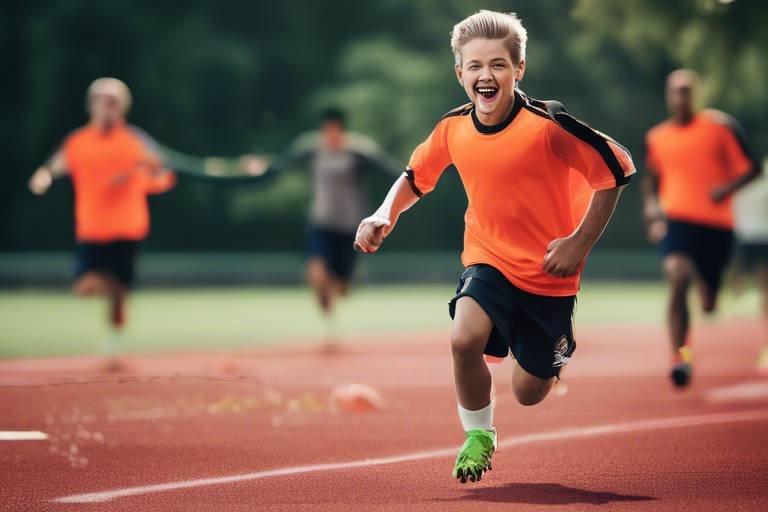The Importance of Consistent Reinforcement in Training
In the world of training, whether it be for animals, employees, or students, one fundamental principle stands out: consistent reinforcement. Imagine trying to build a house without a solid foundation; it just won’t stand the test of time. Similarly, without consistent reinforcement, the training process can crumble, leaving learners confused and unmotivated. This article delves into the crucial role that consistent reinforcement plays in effective training, highlighting its numerous benefits, techniques, and the profound impact it has on learning and behavior modification.
Reinforcement is not just a buzzword; it’s a powerful tool in the learning process. It helps to strengthen desired behaviors and skills, much like a gardener nurturing a plant to help it grow. When we understand the role reinforcement plays, we can significantly enhance training outcomes and promote long-term retention of information. Think of reinforcement as the fuel that powers the engine of learning; without it, progress can stall. By consistently applying reinforcement, trainers can create an environment where learners feel supported and encouraged to strive for improvement.
Reinforcement can be broadly categorized into two types: positive and negative. Each type serves distinct purposes in training, and recognizing their distinctions can help trainers apply the most effective techniques. While positive reinforcement involves rewarding desired behaviors, negative reinforcement focuses on the removal of unpleasant stimuli to encourage those same behaviors. It’s essential to understand that both types can coexist and complement each other in the training process, much like two sides of a coin.
Positive reinforcement is all about rewards and recognition. It involves rewarding desired behaviors to encourage their repetition, creating a cycle of motivation and success. Techniques can vary widely, from verbal praise to tangible rewards. For instance, offering a small gift or a certificate of achievement can significantly boost a learner’s motivation. Here are some effective methods of positive reinforcement:
- Praise: Simple yet powerful, verbal praise can uplift spirits and reinforce good behavior.
- Rewards: Tangible rewards can create excitement and anticipation, making learners eager to achieve.
- Incentives: Offering incentives for reaching specific milestones can keep learners engaged and motivated.
Utilizing tangible rewards and incentives can significantly boost motivation and engagement in training. For example, consider a classroom setting where students receive points for completing assignments. These points can be redeemed for prizes, creating a fun and competitive atmosphere. Implementing rewards effectively involves understanding what motivates your learners and tailoring your approach accordingly. This could mean offering different types of rewards to cater to diverse preferences, ensuring that every learner feels valued.
Verbal praise is a powerful tool for reinforcing positive behavior. It’s like a warm hug for the mind; it boosts self-esteem and fosters a sense of accomplishment. When learners receive praise, they are more likely to repeat the behavior that earned them that recognition. The psychological effects of praise can be profound, enhancing motivation and instilling a desire to excel. Trainers should strive to be specific in their praise—rather than a generic “good job,” try something like, “I love how you worked through that problem!” This specificity makes the praise feel genuine and impactful.
Negative reinforcement can often be misunderstood. It’s not about punishment; rather, it involves the removal of unpleasant stimuli to encourage desired behaviors. For example, if a student dislikes homework but completes their assignments on time, the trainer might reduce the amount of homework as a reward for good behavior. This method can be effective when applied thoughtfully, ensuring that learners do not feel distressed or resentful. The goal is to create a positive learning environment where learners feel supported, not penalized.
Consistency is the backbone of effective reinforcement. Without it, learners can become confused and unsure of what is expected of them. Imagine trying to learn a new skill but receiving mixed signals about what behaviors are rewarded. This inconsistency can lead to frustration and disengagement. By applying reinforcement uniformly, trainers can ensure that learners understand expectations and feel confident in their efforts.
Creating a systematic reinforcement schedule can help maintain motivation over time. Just like a well-planned diet helps maintain health, a reinforcement schedule can keep learners on track. Various scheduling strategies can be employed, including:
- Fixed Reinforcement Schedule: Rewards are given after a set number of responses.
- Variable Reinforcement Schedule: Rewards are given at unpredictable intervals, keeping learners engaged and excited.
Every learner is unique, and adapting reinforcement strategies based on individual needs is crucial for success. This means recognizing different learning styles and preferences, much like a chef adjusting a recipe to suit different tastes. By tailoring reinforcement approaches, trainers can create a more inclusive and effective learning environment, ensuring that all learners feel supported and motivated.
Q: What is the difference between positive and negative reinforcement?
A: Positive reinforcement involves rewarding desired behaviors, while negative reinforcement involves removing unpleasant stimuli to encourage those behaviors.
Q: How can I ensure consistency in reinforcement?
A: Establish clear expectations and apply reinforcement uniformly across all learners to avoid confusion.
Q: Can negative reinforcement be harmful?
A: If applied incorrectly, negative reinforcement can lead to distress. It’s essential to focus on creating a supportive environment.
Q: How do I know what type of reinforcement to use?
A: Consider the individual needs and preferences of your learners. Tailor your approach to maximize engagement and motivation.

The Role of Reinforcement in Learning
Reinforcement plays a critical role in the learning process, acting as a catalyst that helps to solidify desired behaviors and skills. Imagine trying to teach a dog to sit; without some form of reinforcement, the dog may not understand the connection between the command and the action. This principle applies equally to human learning. When we reinforce a behavior, we are essentially strengthening the neural pathways that lead to that behavior. The more we reinforce, the more likely it is that the behavior will be repeated. This process not only enhances immediate learning outcomes but also promotes long-term retention of information.
Understanding the role of reinforcement can significantly enhance training outcomes. For instance, when a student answers a question correctly and receives a reward, they are more likely to engage in similar behaviors in the future. This is not just about immediate gratification; it’s about building a foundation for future learning. The brain starts to associate the positive experience with the learning process, creating a cycle of motivation and achievement.
Moreover, reinforcement can be both intrinsic and extrinsic. Intrinsic reinforcement occurs when the learner finds personal satisfaction or joy in the task itself, while extrinsic reinforcement involves external rewards like praise or tangible items. Both types are essential, but they serve different purposes in the learning journey. For example, a student who enjoys solving math problems may be intrinsically motivated, while another may need the promise of a reward to engage fully. Understanding these differences allows trainers and educators to tailor their approaches, making the learning experience more effective.
In addition to motivation, reinforcement also aids in behavior modification. When undesirable behaviors are not reinforced, they tend to diminish over time. This is where the concept of negative reinforcement comes into play, as removing an unpleasant stimulus can encourage desired behavior. For instance, if a student dislikes being called out for incorrect answers, they may start to prepare more thoroughly to avoid that discomfort. Thus, reinforcement is not just about rewarding good behavior; it’s also about creating an environment that fosters positive change.
To sum it up, reinforcement is a powerful tool in the learning process. It not only helps in establishing and strengthening desired behaviors but also plays a vital role in maintaining motivation and facilitating behavior modification. By understanding and applying the principles of reinforcement, trainers and educators can create a more engaging and effective learning environment.

When we talk about reinforcement, it’s crucial to understand that it comes in two main flavors: positive and negative. But wait, don’t let the term “negative” throw you off! In the world of training and behavior modification, these terms don’t mean what they seem at first glance. Instead, they refer to different methods of encouraging desired behaviors. Understanding these types is like having a toolbox—each tool has its specific use, and knowing when to use which can make all the difference in achieving effective training outcomes.
Positive reinforcement is all about adding something desirable to encourage a behavior. Think of it as giving a dog a treat for sitting on command. This method not only reinforces the behavior but also creates a positive association with the action. On the other hand, negative reinforcement involves removing an unpleasant stimulus when a desired behavior occurs. For example, if a student studies hard to avoid the stress of failing an exam, they are experiencing negative reinforcement. It’s important to note that while both methods aim to increase the likelihood of a behavior being repeated, they do so through different mechanisms.
Let’s break it down further:
- Positive Reinforcement: Involves adding a reward after a desired behavior. This could be in the form of praise, gifts, or privileges.
- Negative Reinforcement: Involves removing an adverse condition when the desired behavior occurs. This could mean alleviating pressure or discomfort when the individual meets certain expectations.
Recognizing the differences between these types of reinforcement allows trainers and educators to tailor their approaches effectively. For instance, in a classroom setting, a teacher might use positive reinforcement by giving stickers for good behavior, while simultaneously employing negative reinforcement by reducing homework for students who consistently turn in their assignments on time. This dual approach can create a balanced environment that promotes learning and positive behavior.
But that’s not all! The effectiveness of these reinforcement types can also depend on the context and the individual receiving the training. Some learners may respond better to positive reinforcement, finding motivation in praise and rewards, while others might thrive under negative reinforcement, appreciating the removal of stressors. Thus, understanding the nuances of each type can lead to more personalized and effective training strategies.
In summary, both positive and negative reinforcement play vital roles in shaping behavior and enhancing learning. By leveraging these techniques appropriately, trainers can create an environment that not only fosters growth but also encourages a love for learning.
When it comes to training, positive reinforcement is like the secret sauce that makes everything better. Imagine you're a coach encouraging your team; every time they score, you cheer them on! This is the essence of positive reinforcement—it’s about rewarding those desired behaviors to ensure they happen again. But what exactly does this look like in practice? Well, let’s dive into various techniques that can make your training sessions not just effective, but also enjoyable.
One of the most straightforward yet powerful methods is praise. Think about it: a simple "Great job!" or "I love how you did that!" can boost someone's confidence immensely. Praise acts as a motivating force, reinforcing the behavior you've just witnessed. It’s important to be specific with your praise as well; instead of a generic compliment, try saying, "I really liked how you approached that problem creatively!" This not only makes the learner feel good but also gives them clear feedback on what they did right.
Another effective technique is the use of rewards and incentives. Picture this: you’re in a classroom, and you have a chart where students earn stickers for every task completed. Once they hit a certain number, they get a prize. This kind of tangible reward can significantly enhance motivation and engagement. The key here is to ensure that the rewards are meaningful to the learners. For example, if you're training a group of young adults, a gift card to a popular coffee shop might be more enticing than a sticker. Understanding your audience is crucial in implementing this technique successfully.
To make this even clearer, let’s take a look at a simple table that outlines different types of rewards:
| Type of Reward | Description |
|---|---|
| Tangible Rewards | Physical items like gift cards or snacks that can be given for achieving specific goals. |
| Experiential Rewards | Opportunities for experiences such as a day off or a fun outing. |
| Social Rewards | Recognition in front of peers, such as certificates or verbal praise. |
Moreover, verbal praise is complemented well by non-verbal cues. A thumbs-up, a smile, or even a high-five can go a long way in reinforcing positive behavior. These gestures communicate approval and can make learners feel valued. It’s like giving them a pat on the back without saying a word!
Incorporating these techniques into your training doesn’t have to be complicated. The goal is to create an environment where learners feel appreciated and motivated. By recognizing their efforts, you're not just helping them to learn; you're also fostering a culture of positivity and growth. So, the next time you're training someone, remember: a little praise and a few well-placed rewards can make all the difference!
As we explore these techniques, it's essential to keep in mind that the effectiveness of positive reinforcement can vary based on individual preferences. Some might respond better to verbal praise, while others might thrive on tangible rewards. Thus, being adaptable and observant is key to maximizing the benefits of positive reinforcement in your training sessions.
- What is positive reinforcement? Positive reinforcement is a technique used to encourage desired behaviors by providing rewards or praise.
- How can I effectively use praise in training? Be specific with your compliments and make sure to acknowledge the behavior you want to reinforce.
- Are tangible rewards necessary? While not always necessary, tangible rewards can significantly enhance motivation, especially in competitive settings.
- Can positive reinforcement work for adults? Absolutely! Adults respond well to positive reinforcement, just like children, especially when the rewards are meaningful to them.
When it comes to training, rewards and incentives are like the icing on the cake. They not only sweeten the learning experience but also serve as powerful motivators that can propel individuals toward achieving their goals. Imagine being a student who has just completed a challenging project; receiving a small reward or acknowledgment can make that effort feel worthwhile. This psychological boost is what makes rewards so effective in training environments.
Utilizing tangible rewards can significantly enhance motivation and engagement. Think of rewards as fuel for the learning engine. When learners are aware that their efforts will be recognized and rewarded, they are more likely to put in the extra effort. But what types of rewards are most effective? Here are a few examples:
- Gift Cards: A small gift card can be a great incentive for completing tasks or reaching milestones.
- Certificates: Recognizing achievements with certificates can instill a sense of accomplishment.
- Public Recognition: Acknowledging someone's efforts in front of peers can boost morale and encourage others.
However, it's essential to implement these rewards thoughtfully. If rewards are given too frequently or without clear criteria, they can lose their value. It’s like giving out trophies for just showing up; eventually, the excitement fades. To maximize the impact of rewards, trainers should establish clear goals and criteria for earning them. This way, learners will feel a genuine sense of achievement when they receive their rewards.
Incorporating incentives into training programs can also take various forms. For instance, offering extra credit for completing additional assignments or providing access to exclusive resources can motivate learners to go above and beyond. The key is to tailor these incentives to the interests and needs of the learners. By doing so, you not only enhance their experience but also increase the likelihood of sustained engagement.
Moreover, it’s vital to remember that rewards don’t always have to be material. Sometimes, a simple verbal acknowledgment or a heartfelt note can make a world of difference. The emotional connection that comes from genuine praise can often outweigh any physical reward. This dual approach—combining tangible rewards with emotional recognition—creates a rich tapestry of motivation that can lead to remarkable outcomes.
In summary, rewards and incentives are powerful tools in the training arsenal. They not only encourage learners to engage actively but also reinforce positive behaviors, making the learning process more enjoyable and effective. By carefully considering how to implement these rewards, trainers can create an environment where learners feel valued and motivated to succeed.
Q1: What types of rewards are most effective in training?
A1: Effective rewards can range from tangible items like gift cards and certificates to intangible rewards such as public recognition and praise. The key is to align rewards with the interests of the learners.
Q2: How can I ensure that rewards maintain their value?
A2: To maintain the value of rewards, it’s crucial to establish clear criteria for earning them and to avoid giving them out too frequently. This creates a sense of achievement and anticipation.
Q3: Can verbal praise be as effective as tangible rewards?
A3: Yes, verbal praise can be incredibly effective. It fosters an emotional connection and can boost self-esteem, often making it just as impactful as physical rewards.
Praise is more than just a few kind words; it’s a powerful catalyst for growth and motivation in any learning environment. When we recognize and commend a learner's efforts, we’re not merely acknowledging their achievements; we’re reinforcing the behaviors that led to those successes. Think of praise as the fuel that keeps the engine of motivation running smoothly. Without it, learners may struggle to find the drive to continue pushing themselves.
The psychological effects of praise are profound. When learners receive positive feedback, it can significantly enhance their self-esteem and confidence. This is especially true for individuals who may doubt their abilities. A simple "Great job!" or "I love how you approached that problem!" can ignite a spark of enthusiasm that propels them forward. It’s as if you’ve handed them a shiny trophy that symbolizes their hard work, making them eager to earn another one.
Moreover, praise can create a positive feedback loop. When learners feel acknowledged, they’re more likely to engage in the desired behavior again. For example, if a student receives praise for participating in class discussions, they may feel more inclined to speak up in the future. This not only benefits the individual but also fosters a supportive learning environment where everyone feels valued. To illustrate this point, consider the following table that highlights the impact of praise on different aspects of learning:
| Aspect | Impact of Praise |
|---|---|
| Self-Esteem | Boosts confidence and encourages risk-taking. |
| Engagement | Increases participation and interest in learning activities. |
| Motivation | Enhances intrinsic motivation and desire to improve. |
| Behavior Reinforcement | Encourages repetition of positive behaviors. |
However, it’s crucial to ensure that praise is genuine and specific. Vague compliments like "Good job!" can sometimes fall flat, leaving learners uncertain about what they did right. Instead, consider being more specific: "I really appreciate how you worked through that problem step by step. It shows your understanding!" This type of feedback not only reinforces the behavior but also clarifies what exactly is being praised, making it more impactful.
In conclusion, praise as reinforcement is an essential tool in any training or educational setting. It nurtures a culture of positivity and encourages learners to strive for excellence. By recognizing achievements, both big and small, we can create an environment where individuals feel empowered to learn and grow. So, the next time you see someone achieve, don’t hold back—offer that praise! It could be the very thing that inspires them to reach new heights.
- What is the best way to give praise? Be specific and genuine. Highlight the exact behavior or achievement you are recognizing.
- Can too much praise be harmful? Yes, excessive praise can lead to dependency on external validation. Balance is key!
- How does praise affect motivation? Praise boosts motivation by reinforcing positive behaviors and making learners feel valued.
Negative reinforcement is often misunderstood, yet it plays a pivotal role in shaping behavior. Unlike punishment, which aims to decrease undesirable behaviors, negative reinforcement focuses on encouraging desired actions by removing unpleasant stimuli. Think of it as a way to clear the path for positive behavior, like removing obstacles from a road to make driving smoother. By understanding and applying negative reinforcement techniques effectively, trainers can help learners navigate their challenges without feeling overwhelmed.
One of the most effective techniques in negative reinforcement is the use of escape learning. This occurs when a learner is taught to perform a specific behavior to escape an aversive situation. For instance, consider a student who struggles with math homework. If the student learns that completing the assignment allows them to avoid the stress of a looming deadline, they are more likely to engage in the behavior of completing their work. This technique not only promotes the desired behavior but also helps alleviate anxiety, creating a win-win situation.
Another technique involves the concept of avoidance learning. In this scenario, learners are taught to avoid negative outcomes by engaging in positive behaviors. For example, a dog may learn to sit on command to avoid the unpleasantness of being left alone. By reinforcing this behavior, trainers can help the dog associate sitting with a positive outcome—like receiving affection or treats—while simultaneously removing the stress of being neglected. This technique is particularly effective in training sessions, where the goal is to create a safe and supportive environment for learning.
However, it’s crucial to apply negative reinforcement carefully to avoid feelings of distress or resentment. If learners perceive the reinforcement as punitive, it could backfire, leading to anxiety or resistance. Therefore, transparency and communication about the reinforcement process are essential. For example, when implementing negative reinforcement in a classroom setting, teachers can explain the rationale behind their methods, ensuring students understand that the goal is to foster a positive learning experience.
To illustrate the effectiveness of negative reinforcement techniques, consider the following table that compares different methods:
| Technique | Description | Example |
|---|---|---|
| Escape Learning | Performing a behavior to escape an aversive situation. | Completing homework to avoid stress. |
| Avoidance Learning | Learning to avoid negative outcomes by engaging in positive behaviors. | A dog sits to avoid being left alone. |
In conclusion, negative reinforcement can be a powerful tool when applied thoughtfully and consistently. By focusing on removing negative stimuli, trainers can encourage desired behaviors and create a more conducive learning environment. Remember, the goal is to guide learners toward success while minimizing discomfort, paving the way for a more engaging and effective training experience.
- What is negative reinforcement? Negative reinforcement is a technique used to encourage desired behaviors by removing unpleasant stimuli.
- How does negative reinforcement differ from punishment? While negative reinforcement aims to increase a behavior by removing negative conditions, punishment seeks to decrease a behavior by introducing negative consequences.
- Can negative reinforcement be applied in all learning environments? Yes, but it should be applied carefully to avoid feelings of distress or resentment among learners.
- What are some examples of negative reinforcement? Examples include allowing a student to leave a stressful situation after completing an assignment or training a pet to avoid unpleasant sounds by performing a desired action.

When it comes to training, whether you're working with animals, children, or adults, one principle stands out above the rest: consistency. Imagine trying to learn a new skill, like riding a bike, but your instructor changes the rules every time you practice. Frustrating, right? This is precisely what happens when reinforcement is applied inconsistently. The learner becomes confused, unsure of what behaviors are expected or rewarded. To avoid this chaos, trainers must apply reinforcement uniformly, creating a clear and predictable learning environment.
Consistency in reinforcement not only clarifies expectations but also builds trust between the trainer and the learner. When individuals know what to expect, they feel more secure and are more likely to engage fully in the learning process. This sense of security can lead to greater motivation and a willingness to take risks, which are essential for effective learning. Inconsistent reinforcement, on the other hand, can lead to anxiety and frustration, ultimately hindering progress.
To truly harness the power of consistent reinforcement, it’s essential to establish a clear reinforcement schedule. This means determining when and how reinforcement will be provided. For instance, trainers might choose to implement a fixed schedule, where reinforcement is provided after a set number of responses, or a variable schedule, where reinforcement is given at unpredictable intervals. Each of these schedules has its advantages and can be tailored to fit the specific needs of the learner. Below is a simple table that outlines these reinforcement schedules:
| Reinforcement Schedule | Description | Example |
|---|---|---|
| Fixed Ratio | Reinforcement after a specific number of responses | Rewarding a learner after every 5 correct answers |
| Variable Ratio | Reinforcement after an unpredictable number of responses | Slot machines that pay out after a random number of plays |
| Fixed Interval | Reinforcement after a specific amount of time has passed | Weekly quizzes that provide rewards based on performance |
| Variable Interval | Reinforcement after varying amounts of time | Surprise tests that reward students for their ongoing effort |
In addition to establishing a reinforcement schedule, trainers should also be prepared to adapt their strategies to meet the individual needs of their learners. Not everyone responds to reinforcement in the same way, and being flexible can make a significant difference in outcomes. For example, some learners may thrive on verbal praise, while others might be more motivated by tangible rewards. By observing and understanding the unique preferences of each learner, trainers can create a more effective and engaging training experience.
Ultimately, the key takeaway is that consistency in reinforcement is not just a best practice; it's a necessity for effective training. By applying reinforcement uniformly and adapting strategies to fit individual needs, trainers can foster an environment where learners feel supported, motivated, and empowered to succeed. So, the next time you embark on a training journey, remember: consistency is your best friend!
- Why is consistency important in reinforcement? Consistency helps learners understand expectations and reduces confusion, leading to better engagement and motivation.
- What are some effective reinforcement schedules? Fixed ratio, variable ratio, fixed interval, and variable interval are common schedules that can be tailored to specific training needs.
- How can I adapt reinforcement strategies for different learners? Observe individual preferences and adjust your approach—some may prefer verbal praise, while others may respond better to tangible rewards.
When it comes to training, establishing a reinforcement schedule is like setting the rhythm for a dance; it keeps everything in sync and ensures that learners are motivated and engaged throughout the process. A well-structured reinforcement schedule can significantly enhance the effectiveness of your training efforts. But what exactly does this mean? Essentially, it involves determining when and how often to provide reinforcement in response to desired behaviors. This can be a game-changer in promoting consistent learning and behavior modification.
There are two primary types of reinforcement schedules: fixed and variable. Each has its unique benefits and can be tailored to fit the specific needs of your training program. A fixed reinforcement schedule provides rewards after a set number of responses or after a specific time period. For example, you might reward a learner with a small prize after they complete five tasks. This predictability can be comforting and can help learners understand exactly what they need to do to earn their rewards.
On the other hand, a variable reinforcement schedule can create a sense of excitement and anticipation. In this case, rewards are given out at unpredictable intervals. Think of it like a slot machine; you never know when you might hit the jackpot! This unpredictability can keep learners on their toes and can lead to higher levels of engagement and motivation. However, it’s essential to strike a balance and not make the schedule so inconsistent that learners become frustrated or confused.
| Reinforcement Schedule Type | Description | Advantages |
|---|---|---|
| Fixed Schedule | Rewards are given after a specified number of responses or time. | Predictable, helps learners understand expectations. |
| Variable Schedule | Rewards are given at unpredictable intervals. | Increases excitement and engagement, encourages persistence. |
Another important aspect of establishing a reinforcement schedule is the timing of the reinforcement itself. Immediate reinforcement tends to be more effective than delayed reinforcement. When learners receive a reward right after demonstrating a desired behavior, it helps them make a clear connection between their actions and the outcomes. Imagine teaching a dog to sit; if you give them a treat immediately after they sit, they’ll quickly learn that sitting leads to a tasty reward. The same principle applies to human learning.
Moreover, it’s crucial to regularly evaluate and adjust your reinforcement schedule as needed. Just like a gardener tends to their plants, you need to monitor the growth of your learners and adapt your strategies accordingly. If you notice that motivation is waning or that learners are not responding as expected, it may be time to tweak your reinforcement schedule. This could mean increasing the frequency of rewards, changing the types of rewards used, or even switching from a fixed to a variable schedule to reignite interest.
In conclusion, establishing a reinforcement schedule is a vital part of effective training. It not only helps maintain motivation but also fosters an environment where learners feel valued and understood. By carefully considering the type of schedule, the timing of reinforcement, and the need for adaptability, trainers can create a powerful framework that enhances learning outcomes and behavior modification.
- What is the best type of reinforcement schedule? The best type depends on the specific training goals and the learners involved. Fixed schedules provide predictability, while variable schedules can enhance excitement.
- How often should I provide reinforcement? It's essential to find a balance. Too much reinforcement can lead to dependency, while too little can cause disengagement.
- Can I use both fixed and variable schedules? Absolutely! Many trainers find that a combination of both can be very effective in keeping learners engaged and motivated.
When it comes to training, one size definitely does not fit all. Just like how everyone has unique tastes in food, learners come with distinct preferences, motivations, and learning styles. This is where the magic of adapting reinforcement strategies comes into play. By tailoring your approach, you can create a more engaging and effective learning environment that resonates with each individual.
Think of it like customizing a recipe: while the basic ingredients might be the same, the flavors and spices can be adjusted to suit different palates. In training, adapting reinforcement means assessing the needs of your learners and modifying your techniques accordingly. For instance, some learners might thrive on verbal praise, while others may respond better to tangible rewards. The key is to observe and understand what drives each learner’s motivation.
To get started, consider the following factors when adapting your reinforcement strategies:
- Learning Styles: Some individuals are visual learners, while others may be auditory or kinesthetic. Tailoring your reinforcement to match these styles can enhance understanding and retention.
- Personal Interests: Incorporating elements that reflect a learner's interests can make reinforcement more impactful. For example, if a learner loves sports, using sports-related rewards can boost their motivation.
- Individual Goals: Each learner may have different objectives. Aligning reinforcement with their personal goals can foster a sense of ownership and commitment to the learning process.
Moreover, flexibility is crucial. Just as a skilled musician adapts their performance based on the audience's reaction, trainers should be ready to adjust their reinforcement strategies based on feedback and results. Regular check-ins with learners can provide valuable insights into what’s working and what isn’t. This way, you can pivot your approach to ensure that it remains effective and engaging.
Another vital aspect is the timing of reinforcement. Some learners benefit from immediate feedback, while others may prefer a more delayed approach. By observing how learners respond to different timings, you can fine-tune your reinforcement schedule to maximize its effectiveness. Remember, the goal is to create a supportive and motivating environment that encourages learners to reach their full potential.
In conclusion, adapting reinforcement strategies is not just about changing techniques; it's about understanding your learners on a deeper level. By being attentive to their needs, you can foster a more effective learning experience that not only enhances knowledge retention but also builds confidence and enthusiasm. So, take the time to get to know your learners, and don’t hesitate to mix things up a bit. After all, the best trainers are those who are willing to evolve and grow alongside their learners.
- What is the importance of adapting reinforcement strategies?
Adapting reinforcement strategies is essential because it allows trainers to cater to the unique needs and preferences of each learner, enhancing motivation and engagement. - How can I determine which reinforcement strategy works best?
Observing learners' responses, conducting regular check-ins, and being open to feedback can help identify the most effective reinforcement strategies for individuals. - Can reinforcement strategies be adapted over time?
Absolutely! As learners progress, their needs and motivations may change, so it's important to continuously assess and adapt reinforcement strategies to remain effective.
Frequently Asked Questions
- What is reinforcement in training?
Reinforcement in training refers to the process of encouraging desired behaviors by providing rewards or removing unpleasant stimuli. It plays a vital role in enhancing learning and promoting behavior modification.
- What are the different types of reinforcement?
Reinforcement can be categorized into two main types: positive reinforcement, which involves rewarding desired behaviors, and negative reinforcement, which involves removing adverse stimuli to promote those behaviors. Understanding these types can help trainers apply effective techniques.
- How does positive reinforcement work?
Positive reinforcement works by providing rewards, such as praise or tangible incentives, to encourage the repetition of desired behaviors. This method boosts motivation and engagement, making the learning experience more enjoyable and effective.
- Can you give examples of positive reinforcement techniques?
Absolutely! Some effective positive reinforcement techniques include verbal praise, providing tangible rewards like gift cards or certificates, and using incentives such as extra privileges or points in a game setting.
- What is negative reinforcement, and how is it applied?
Negative reinforcement involves the removal of unpleasant factors to encourage a desired behavior. For instance, if a learner completes a task to avoid extra homework, the unpleasant stimulus (the extra homework) is removed, reinforcing the behavior of completing tasks on time.
- Why is consistency important in reinforcement?
Consistency is crucial because it helps learners understand expectations and reduces confusion. When reinforcement is applied uniformly, it strengthens the learning process and ensures that desired behaviors are reliably reinforced.
- What is a reinforcement schedule?
A reinforcement schedule is a systematic plan for when and how reinforcement is delivered. It can be fixed, where rewards are given after a set number of responses, or variable, where rewards are given unpredictably, keeping learners engaged and motivated.
- How can reinforcement strategies be adapted to individual needs?
Reinforcement strategies can be tailored by assessing individual learning styles and preferences. For example, some learners may respond better to verbal praise, while others may prefer tangible rewards. Adapting these strategies ensures that each learner receives the support they need to thrive.



















